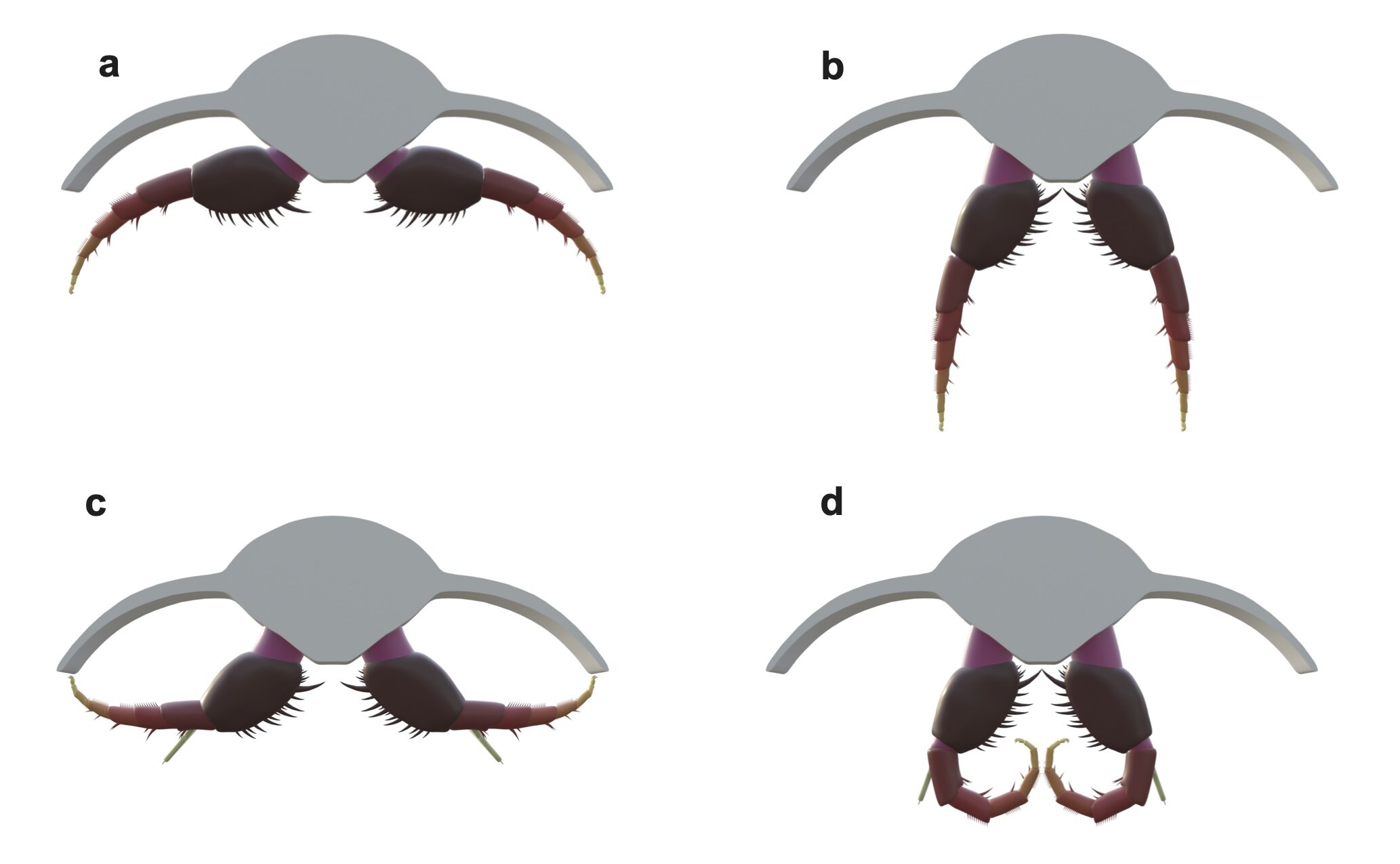🦴 These trilobite limbs reveal unexpected dynamism
Follow us on Google News (click on ☆)
Arthropods, like modern insects or crustaceans, possess articulated limbs composed of several segments that allow them to move, dig, or grasp food. These movements depend on the range of flexion and extension of each joint. To understand how trilobite limbs functioned, scientists analyzed 156 limbs from 28 fossil specimens, using advanced 3D modeling techniques to reconstruct their precise movements.

A complete specimen with antennae and limbs (USNM PAL 65510) and the limbs of GSC 34695a showing various degrees of flexion and extension.
Credit: Sarah R. Losso
Unlike horseshoe crabs, often compared to trilobites although they belong to a different branch of arthropods, Olenoides serratus had a simpler but highly functional limb design. Its limbs had a reduced range of extension, mainly in the part farthest from the body, which allowed it to walk, dig into sediments, bring food to its mouth, and even lift its body above the seafloor to move through turbulent waters.
The researchers also discovered that males possessed specialized appendages for mating, and that each limb was equipped with a gill for respiration. This revelation adds a behavioral dimension to our understanding of these animals, showing that they led active lives. The rarity of such details in fossils is explained by the difficulty of preserving soft tissues, which require very specific conditions like those of the Burgess Shale, where rapid underwater landslides preserved these delicate structures.

Model showing different combinations of flexion and extension allowing the animal to stand, dig, or bring food.
Credit: Walker C. Weyland
This study, published in BMC Biology, opens a unique window into the dynamic life of the ancient oceans, revealing how trilobites not only survived but thrived thanks to their sophisticated limbs. It highlights the importance of analogies with modern animals, while shedding light on the evolutionary differences that shaped the success of these ancient sea dwellers.
Exceptional fossilization of the Burgess Shale
The Burgess Shale is a fossil site located in the Canadian Rocky Mountains, famous for its remarkable preservation of soft tissues from organisms around 508 million years old. Unlike most fossils, which preserve only hard parts like bones or shells, this site has preserved fine details such as limbs, intestines, and even the eyes of various marine creatures.
This exceptional preservation is due to unique geological conditions: underwater avalanches of fine mud rapidly buried organisms, depriving them of oxygen and limiting decomposition. This process, called obrution preservation, trapped specimens in a nearly intact state, offering scientists an unprecedented glimpse into life during the Cambrian period.
The Burgess Shale was discovered in 1909 by paleontologist Charles Walcott and has since revealed over 65,000 specimens belonging to more than 170 species. Among them are many primitive arthropods, including trilobites, which dominate the fossil assemblages and provide information on the early evolution of animals.
Today, the site is a UNESCO World Heritage Site and continues to be studied to understand how these ancient environments influenced biodiversity. Recent research, such as that on Olenoides serratus, relies on these fossils to reconstruct not only the anatomy but also the behavior and ecology of these extinct organisms.
Evolution of limbs in arthropods
Arthropods form the largest group of animals on Earth, including insects, arachnids, crustaceans, and extinct trilobites. Their evolutionary success is largely due to their articulated limbs, which give them great adaptability for moving, feeding, and interacting with their environment.
These limbs are composed of rigid segments connected by flexible joints, allowing a range of movements such as flexion (downward movement) and extension (upward movement). The morphology of each segment, as well as the range of motion, determines the specific function of the limb, for example for walking, swimming, or predation.
In trilobites like Olenoides serratus, the limbs were likely used for a variety of tasks, including locomotion on the seafloor, digging into sediments to hide or search for food, and manipulating objects. The presence of gills on each limb also indicates an adaptation to aquatic respiration, essential for life in the ancient oceans.
The study of fossil limbs helps trace the evolutionary history of arthropods, showing how simple designs could evolve into more specialized structures in modern groups. This illustrates the importance of morphological plasticity in the adaptive radiation that characterized the Cambrian explosion, a key period of life diversification on Earth.